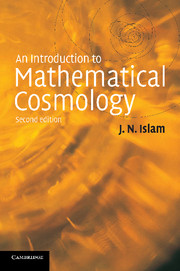Book contents
- Frontmatter
- Contents
- Preface to the first edition
- Preface to the second edition
- Dedication
- 1 Some basic concepts and an overview of cosmology
- 2 Introduction to general relativity
- 3 The Robertson–Walker metric
- 4 The Friedmann models
- 5 The Hubble constant and the deceleration parameter
- 6 Models with a cosmological constant
- 7 Singularities in cosmology
- 8 The early universe
- 9 The very early universe and inflation
- 10 Quantum cosmology
- 11 The distant future of the universe
- Appendix
- Bibliography
- Index
1 - Some basic concepts and an overview of cosmology
Published online by Cambridge University Press: 03 February 2010
- Frontmatter
- Contents
- Preface to the first edition
- Preface to the second edition
- Dedication
- 1 Some basic concepts and an overview of cosmology
- 2 Introduction to general relativity
- 3 The Robertson–Walker metric
- 4 The Friedmann models
- 5 The Hubble constant and the deceleration parameter
- 6 Models with a cosmological constant
- 7 Singularities in cosmology
- 8 The early universe
- 9 The very early universe and inflation
- 10 Quantum cosmology
- 11 The distant future of the universe
- Appendix
- Bibliography
- Index
Summary
In this chapter we present an elementary discussion of some basic concepts in cosmology. Although the mathematical formalism is essential, some of the main ideas underlying the formalism are simple and it helps to have an intuitive and qualitative notion of these ideas.
Cosmology is the study of the large-scale structure and behaviour of the universe, that is, of the universe taken as a whole. The term ‘as a whole’ applied to the universe needs a precise definition, which will emerge in the course of this book. It will be sufficient for the present to note that one of the points that has emerged from cosmological studies in the last few decades is that the universe is not simply a random collection of irregularly distributed matter, but it is a single entity, all parts of which are in some sense in unison with all other parts. This, at any rate, is the view taken in the ‘standard models’ which will be our main concern. We may have to modify these assertions when considering the inflationary models in a later chapter.
When considering the large-scale structure of the universe, the basic constituents can be taken to be galaxies, which are congregations of about 10 stars bound together by their mutual gravitational attraction. Galaxies tend to occur in groups called clusters, each cluster containing anything from a few to a few thousand galaxies.
- Type
- Chapter
- Information
- An Introduction to Mathematical Cosmology , pp. 1 - 11Publisher: Cambridge University PressPrint publication year: 2001

